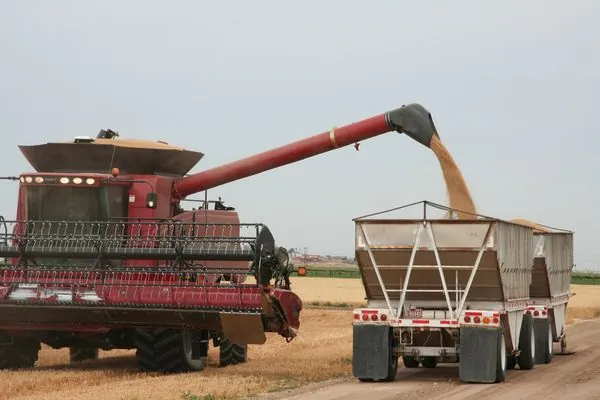Farm Facts That Feed You
Wheat in AZ facts

Back
Facts about Arizona Grains
- Cash receipts for Arizona wheat have ranged from $43 million to $125 million since 2010, according to the USDA.
- American-grown wheat including Desert Durum ® wheat from Arizona is helping feed people around the world: Nigeria, Italy, and Japan.
- Italy demands the highest quality firm pasta and Arizona Desert Durum ® wheat meets or exceeds those needs year after year.
- Wheat has been a substantial portion of Arizona’s cropping acres for a century or more and the past 25 to 30 years and we’ve been concentrating on a premium, superior Arizona wheat, known as Desert Durum. Usually, Arizona’s Durum crop averages about 10% of the Durum wheat in the U.S.
- Wheat grown in Yuma County serves the best rotational crop with produce. The value beyond the wheat itself is the amount of water used on wheat to leach salt below intervening crops.
- University of Arizona research has demonstrated that the southwestern desert water footprint of growing wheat and barley is among the lowest in the world.
- “Italy has been a longstanding market for U.S.-grown wheat. The United States exports about $800 million in agricultural products to Italy annually,” said Geoffrey Wiggin, “agricultural minister with the U.S. Embassy in Rome. Wheat is a big part of that.”
- A high-value part of the wheat imports is the durum wheat grown in Arizona and California. Desert Durum, produced in the desert southwest, is prized by Italian pasta makers for its low moisture, large kernels, and high protein and gluten content. Desert Durum is a trademarked name owned by the Arizona Grain Research and Promotion Council and the California Wheat Commission.
- It all began with Barilla, a major Italian pasta maker, during a trade trip sponsored by the U.S. Wheat Associates to the Yuma area in 1983. A buyer for the company took notice of the wheat here, recalled Mike Edgar, manager of Barkley Seed Co. Barilla has purchased Desert Durum every year since then.
- “Italy’s markets “could represent” about half the crop from this area, which produces about 450,000 tons of durum wheat a year,” Edgar said. “It’s big.” “About 30 percent of the crop stays in the United States for processing, including the American Italian Pasta plant in Tolleson, Ariz.,” he said.
- American Italian Pasta Company’s (AIPC) official opening of its Tolleson, Arizona plant in 2003 brought international recognition to Arizona’s quality Durham wheat.
- Tolleson was chosen as the new AIPC plant site because Arizona’s wheat growers produce the best durum in the nation and having a production facility in the middle of Arizona’s wheat industry makes sense, according to AIPC’s CEO. The company is the largest and fastest-growing producer and marketer of dry pasta in North America.
- Arizona ranks number one in yields of our high-quality, durum wheat. Most U.S. durum is produced in North Dakota and Montana, but Arizona has much higher yields.

- Arizona has had as much as 18% of U.S. durum production (2015) Example: Arizona averages 100 bushels per acre compared to the U.S.’s 30 to 40 bushels an acre, we’re more than double their yield output. We can control our inputs better; varieties and our climate allow for this amazing production.
Ancient Grains
- Ancient Grains have become more popular with the public in the past decade.
- The most popular varieties of ancient grains include Spelt, Freekeh, Quinoa, Millet, Teff, Sorghum, Chia, Amaranth, Kamut, White Sonora, Rouge Bordeaux, Red Fife, Tibetan, Purple Barley, Emmer (Farro), Einkorn.
- Einkorn is the oldest known wheat still grown and was one of the first plants to be domesticated and cultivated. The earliest clear evidence of the domestication of einkorn dates from 10,600 to 9,900 years ago from two archaeological sites in southern Turkey.
- Emmer (Farro), or Jesus wheat, is considered the second oldest grain that exists today. Cooked farro looks and tastes like barley but has a slightly chewier texture and caramel notes.
- In Arizona, we are growing mainly White Sonora, Emmer, Purple Barley, and more.
- Why is Arizona a good place to grow ancient grains? Arizona has 300+ plus days of sunshine and the climate has similarities to the Fertile Crescent where so many of these ancient grains started.
- Ancient grains tend to be higher in protein, omega-3 fatty acids, B vitamins, and zinc.
Our Videos
View all VideosOur Latest Posts

Nutrition for Cycling: How Proper Nutrition Fuels Cyclists from the First Mile to the Finish Line
Cycling is a sport built on rhythm, the turning of your pedals, the cadence of your breath, and the flow of your energy as the…

The Scoop on Salt
For the longest time I never understood why every baking recipe always called for a teaspoon or two of salt, even if the baked good…
Featured Recipes

Provided by: Garry Domingue, Rosie on the House Producer and Foodie












